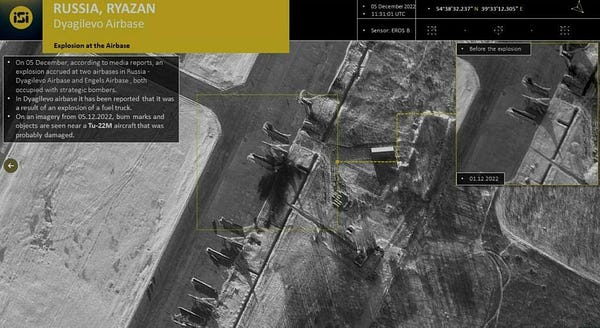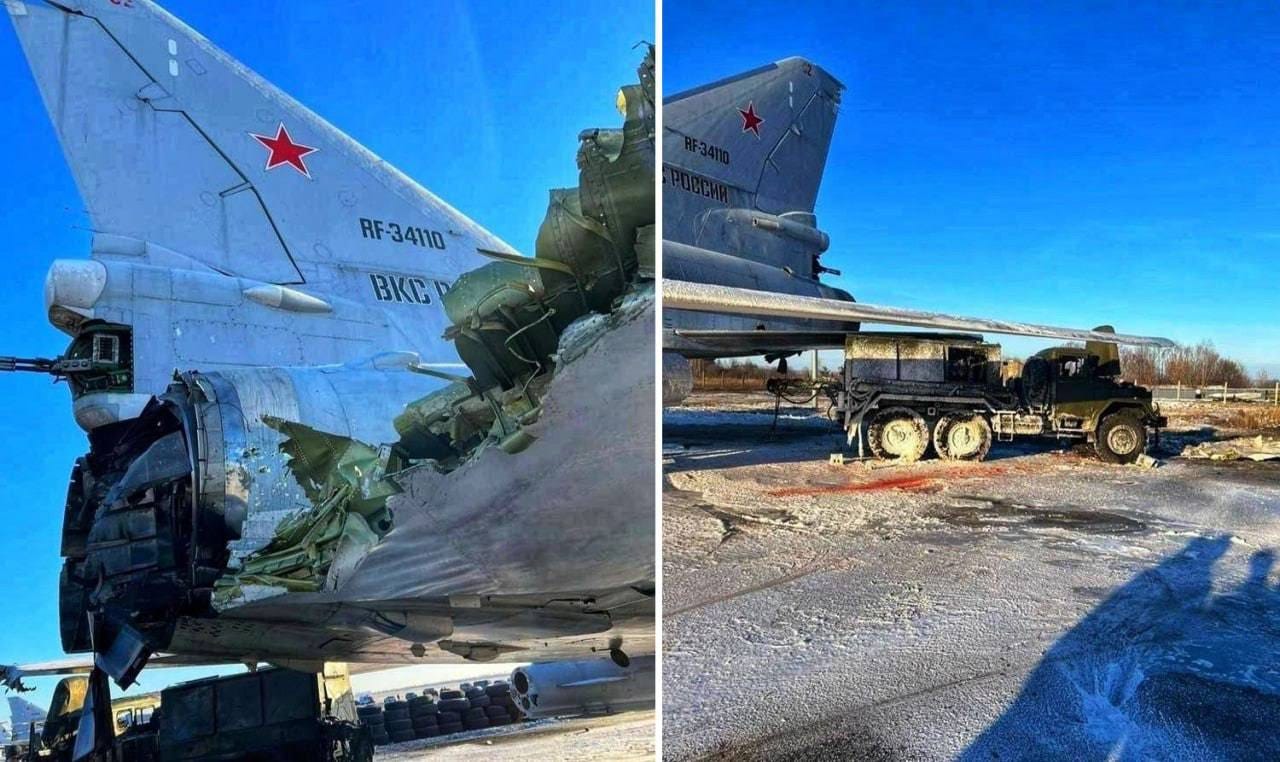Ukraine Strikes Deep Into Russian Territory, Threatens Russia's Nuclear Deterrent Force
In an air strike that did little more than superficial damage, Ukraine nevertheless carried out a drone strike that penetrated deep into Russian territory, and even threatened parts of Russia’s nuclear deterrent force.
Russian news agencies confirmed at least three people were killed, and more injured, in what were initially reported as “explosions” at the airfields near Ryazan and Saratov.
"Three were killed, five were injured. Of the five, two suffered serious bodily harm," the source said, answering a question from a TASS correspondent about the consequences of an explosion at an airfield near Ryazan.
Only later did RIA Novosti confirm that the explosions were the result of unmanned aerial vehicle attacks on the airbases in these regions.
"On the morning of December 5, the Kyiv regime made attempts to strike Soviet-made jet unmanned aerial vehicles at the military airfields of Diaghilevo in the Ryazan region and Engels in the Saratov region," the statement said.
While Russian reports were that the drones were shot down, and the damage inflicted was as the result of falling debris, uncomfirmed video clips being shared on social media and claiming to be of the drone strikes suggest the drones actually reached their targets and detonated.
Ukrainian Telegram Channel Pravda Gerashchenko carried similar footage, not showing but providing audio of what sounds like an aerial overflight coupled with explosions soon after.
Pravda Gerashchenko’s Twitter feed later shared images suggesting slight damage to at least one TU-95 strategic bomber at the Dyagilevo air base near Ryazan.





Of particular note, the Engels air base near Saratov hosts part of Russia’s nuclear deterrent force, and the Tu-95 bombers based there are nuclear-capable.
If confirmed as a Ukrainian operation, the strike on the Engels airbase would be the most daring attack behind Russian lines to date. The airbase is a crucial site for Russian air force operations against Ukraine and for the country’s strategic nuclear forces. It has a nuclear weapons storage bunker with warheads that can be deployed on Russia’s long-range strategic bombers.
Even more significant is the distance these air bases are within Russia from Ukraine. Ryazan is roughly 480 miles from Kyv, and Saratov is more than 600 miles from Kyiv.
As the map shows, the air bases are not close to each other, indicating Ukraine can launch strategic raids not only hundreds of miles into Russian territory but can penetrate Russian air defenses along multiple axes simultaneously. Not only is this a startling display of Ukrainian strategic capabilities, but also of an unexpected strategic Russian vulnerabilities, and the Ukrainian drones threatened a major component of Russia’s nuclear deterrent capability.
While the damage as reported appears to have been largely superficial, with the capabilities of both air bases remaining intact, the implications of the attack are anything but. Ryazan is almost the same distance from Kyiv as Moscow, which makes UAV attacks on Russia’s capital a distinct possibility.
Furthermore, these attacks do not appear to be a one off type of attack. Ukraine has apparently followed up the deep strategic attacks with a more tactical strike closer to the front lines.
A fire broke out early Tuesday at an airport in Russia’s southern Kursk region, which borders Ukraine, the regional governor reported, blaming a drone attack.
The fire occurred the day after Moscow blamed Kyiv for drone strikes on two air bases deep inside Russia and launched another wave of missile strikes on Ukrainian territory.
Also telling is Russia’s response to the attack: yet another mass missile barrage of civilian infrastructure, openly acknowledged as such by Russia, under the rubric of attacking “command and control systems”:
"Despite the attempts of the Kyiv regime to disrupt the combat work of Russian long-range aviation by a terrorist act, today at about 15:00 (Moscow time) a massive strike was carried out on the military command and control system and related facilities of the defense complex, communications centers, energy and military units of Ukraine with precision-guided air and sea-based. All 17 designated objects were hit," the Defense Ministry said.
While Russia claims to be aiming to disrupt Ukrainian logistics, so far its missile barrages have not only failed to do so, but they are not degrading Ukrainian aerial assets either. It is unlikely any of the missile targets in Russia’s latest violation of the Geneva Conventions1 will inhibit future drone attacks into Russian territory, leaving the state of aerial defense around Russian military bases highly problematic.
Setting aside the moral dimensions of Russia’s illegal missile attacks on Ukrainian civilians, there exists a compelling strategic question: why isn’t Russia doing more to target Ukrainian logistics and rear-area bases and supply depots? It is from such facilities that drone strikes such as these latest are launched, and Russia so far has done little to degrade these strategic Ukrainian assets, with the direct result that Ukraine retains the ability to launch strikes deep into Russia, as the Kursk strike strongly indicates.
Russia’s retaliations against Ukrainian strikes into Russia, such as the recently-repaired Kerch Bridge to Crimea, have almost all been against the civilian population, leaving Ukraine’s military capacities largely untouched. Given that these attacks appear to have largely failed in their goal of breaking Ukrainian civilian morale, the attacks arguably represent a squandering of Russia’s missile stocks with little military or strategic political gain to show for it. Ukraine’s attacks into Russia, being more focused, more targeted, and seemingly more efficient in terms of munitions expended, appear to be advancing actual military and strategic goals by highlighting major gaps in Russia’s defenses within Russia.
At a minimum, air defense assets Russia has to deploy around its interior air and military bases to ward off drone strikes are air defense assets that cannot be deployed on the front lines in eastern and southern Ukraine. Even though these attacks caused only superficial damage, if Russia has to redeploy air defense assets in response away from the front lines in Ukraine, the strikes would be a significant strategic win for Ukraine.
Ukraine has once again showed the Russian bear to be far more vulnerable than previously thought. As much as Russian media will strive to downplay the strikes, that vulnerability will not soon fade from international memory. The credibility of the Russian military to the Russian people rests above all else on its ability to defend Russia. Once again, the Russian military has come up short in this all-important primary mission.
It is amply documented that Russia’s missile strikes in Ukraine violate Article 54 of Additional Protocol I to the Geneva Conventions of 12 August 1949, which have been ratified and are binding upon the Russian Federation, making the strikes premeditated war crimes.








How’s the illusion going? Oh, they on to more manufactured fear. The globalists are imploding.
Missile attacks on military bases housing nuclear weapons. Oh, I'm sure this is going to go well.